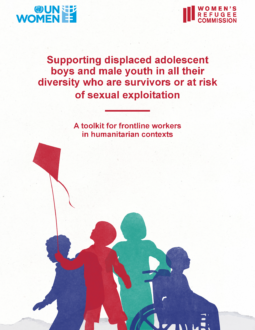
Supporting Displaced Adolescent Boys and Male Youth in All Their Diversity Who Are Survivors Or At Risk of Sexual Exploitation
Published | UpdatedA Toolkit for Frontline Workers in Humanitarian Contexts
Supporting Displaced Adolescent Boys and Male Youth in All Their Diversity Who Are Survivors Or At Risk of Sexual Exploitation: A Toolkit for Frontline Workers in Humanitarian Contexts is a comprehensive resource developed by the Women’s Refugee Commission (WRC), with support from UN Women, to enhance the capacity of frontline workers to integrate protection and support for adolescent boys and male youth (ABMY), including persons with diverse sexual orientation, gender identity, gender expression, and sex characteristics (SOGIESC), into protection programs.
This toolkit is the culmination of years of research under the Sexual Violence Project. Findings from WRC’s earlier research showed that practitioners and service providers lack the tools and resources to effectively address sexual violence perpetrated against male survivors, including ABMY in all their diversity in humanitarian and conflict-affected settings. Additional evidence showed that practitioner and provider attitudes, biases, and misconceptions, as well as a lack of resources were major deterrents for male survivors accessing and receiving quality services and care that meets their immediate and longer-term needs following sexual violence.
To address this one aspect of this gap, WRC developed this toolkit to increase prevention, support, and access to services for displaced adolescent boys (10-19 years) and male youth (15-24 years), including those with diverse SOGIESC, who are survivors or at risk of sexual exploitation. Compiled with evidence-based guidance, capacity enhancing materials, and training exercises and tools, the toolkit primarily focuses on working with adolescent boys under 18 years, but also provides considerations for adult male youth, aged 18 to 24 years.

